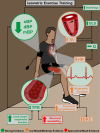Isometric Exercise Training and Arterial Hypertension: An Updated Review
- PMID: 38762832
- PMCID: PMC11239608
- DOI: 10.1007/s40279-024-02036-x
Isometric Exercise Training and Arterial Hypertension: An Updated Review
Abstract
Hypertension is recognised as a leading attributable risk factor for cardiovascular disease and premature mortality. Global initiatives towards the prevention and treatment of arterial hypertension are centred around non-pharmacological lifestyle modification. Exercise recommendations differ between professional and scientific organisations, but are generally unanimous on the primary role of traditional aerobic and dynamic resistance exercise. In recent years, isometric exercise training (IET) has emerged as an effective novel exercise intervention with consistent evidence of reductions in blood pressure (BP) superior to that reported from traditional guideline-recommended exercise modes. Despite a wealth of emerging new data and endorsement by select governing bodies, IET remains underutilised and is not widely prescribed in clinical practice. This expert-informed review critically examines the role of IET as a potential adjuvant tool in the future clinical management of BP. We explore the efficacy, prescription protocols, evidence quality and certainty, acute cardiovascular stimulus, and physiological mechanisms underpinning its anti-hypertensive effects. We end the review with take-home suggestions regarding the direction of future IET research.
© 2024. The Author(s).
Conflict of interest statement
The authors declare that they have no conflicts of interest relevant to the content of this review.
Figures




References
-
- Roth GA, Abate D, Abate KH, Abay SM, Abbafati C, Abbasi N, et al. Global, regional, and national age-sex-specific mortality for 282 causes of death in 195 countries and territories, 1980–2017: a systematic analysis for the Global Burden of Disease Study 2017. Lancet [Internet]. 2018;392:1736–88. - PMC - PubMed
-
- WHO. Cardiovascular diseases (CVDs) [Internet]. 2017. https://www.who.int/news-room/fact-sheets/detail/cardiovascular-diseases.... Cited 8 May 2021.
-
- Lim SS, Vos T, Flaxman AD, Danaei G, Shibuya K, Adair-Rohani H, et al. A comparative risk assessment of burden of disease and injury attributable to 67 risk factors and risk factor clusters in 21 regions, 1990–2010: a systematic analysis for the Global Burden of Disease Study 2010. Lancet. 2012;380:2224–2260. doi: 10.1016/S0140-6736(12)61766-8. - DOI - PMC - PubMed
-
- Allen M. The SAGE encyclopedia of communication research methods. Milwaukee: SAGE Publications Inc.; 2017.
Publication types
MeSH terms
LinkOut - more resources
Full Text Sources
Medical

